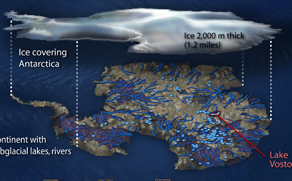How Many Lakes? Numerous lakes exist under the Antarctic Ice Sheet!
 |
Student Activity Worksheet |
|---|---|
| graphic Credit: Zina Deretsky / NSF | download response sheet word pdf |
Estimate Subglacial Lakes
![]() Can you estimate the number of Subglacial Lakes in the Antarctic 'network'? Scientists refer to the large number of lakes and water systems that are under the Antarctic Ice Sheet as a network. They use this term because scientists have found evidence that there are connections between the lakes allowing water to move from one lake to another under the ice sheet. Water can move into one lake and out of another. Water networks that connect are common on Earth, but it was a surprise to find them flowing underneath an ice sheet!
Can you estimate the number of Subglacial Lakes in the Antarctic 'network'? Scientists refer to the large number of lakes and water systems that are under the Antarctic Ice Sheet as a network. They use this term because scientists have found evidence that there are connections between the lakes allowing water to move from one lake to another under the ice sheet. Water can move into one lake and out of another. Water networks that connect are common on Earth, but it was a surprise to find them flowing underneath an ice sheet!
The lakes included in this graphic have been located using radar, but there are still places in Antarctica where scientists don't have the radar data to understand what is under the ice. This means there could be even more lakes. Go to Estimate in 'Try the activity' to see if you can estimate how many lakes scientists have already located. To complete the activities you will want to click on the image to see a large version of what lies underneath the Antarctic Ice Sheet.
To better understand how these lakes are part of an under-ice drainage network with water moving in and out of them, check out this cool animation about Lake Vostok, Antarctica's largest subglacial lake. (You can find Lake Vostok in the image at the top of the page).
Percent Below Sea Level
![]() Sea level is the height of the surface of the ocean where it meets land. On the map key for Antarctica you will see a legend for 'Below sea level'. Why is so much of Antarctica below sea level? It has to do with weight. When glaciers grow on top of continents they add weight and because the continents are floating on the liquid Earth mantle they will start to depress or sink. This happened in North America and Northern Europe in the last Ice Age. As the glaciers melt away the continents will rise back up again, or rebound. This is because the liquid mantle is thick like honey and stretchy like elastic (scientists call it 'viscoelastic') so when the weight is removed it slowly rebounds. This can take many, many years and in fact it is still happening, although the movement is so slow you do not feel it!
Sea level is the height of the surface of the ocean where it meets land. On the map key for Antarctica you will see a legend for 'Below sea level'. Why is so much of Antarctica below sea level? It has to do with weight. When glaciers grow on top of continents they add weight and because the continents are floating on the liquid Earth mantle they will start to depress or sink. This happened in North America and Northern Europe in the last Ice Age. As the glaciers melt away the continents will rise back up again, or rebound. This is because the liquid mantle is thick like honey and stretchy like elastic (scientists call it 'viscoelastic') so when the weight is removed it slowly rebounds. This can take many, many years and in fact it is still happening, although the movement is so slow you do not feel it!
Since Antarctica is covered by a glacier it has been pressed down. Much of the continent is presently below sea level. Go to Percent under 'Try the activity' to see if you can tell what percent of Antarctica is below sea level.



